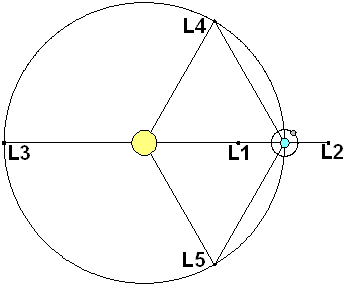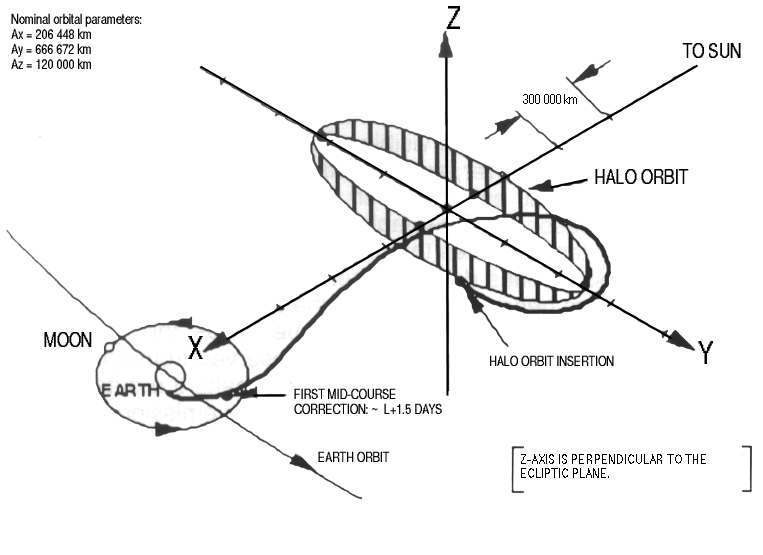| Home | Orbit | Satellite | Power Link | Comm Link | Earth Stations | Cost/Timeline | Employees |
The system uses a constellation of satellites positioned in a large halo orbit at the Earth-Sun Lagrange (L1) point. Taking advantage of the constant Earth-Sun orientation, these satellites can harvest solar power uninterrupted and transmit it to an intermediate satellite in geostationary orbit via laser. The GEO satellite then converts the laser to RF energy and beams that to a ground station on Earth.
Earth-Sun L1 Point
Lagrange points are regions of partial stability in the gravity potential field of a 3-body system (Sun-Earth-Satellite in our case). Five Lagrange points exist at fixed locations in the system of which the L1 point is positioned on a line directly between the planetary bodies. This means that a satellite positioned at the Earth-Sun L1 point will always remain between the Earth and Sun even as the Earth progresses through its yearly orbit. By placing our harvester satellites at L1, we can take advantage of the fixed orientation of the system to dramatically lower the complexity (and therefore cost) of our harvester satellites. The Earth-Sun L1 point is located about 1.5 million kilometers from Earth.

L1 Halo Orbit
Just as any other gravity potential sink (such as a planet) stable orbits can be calculated around L1. Termed 'Halo Orbits', these orbits typically span several hundred thousand kilometers in diameter (in the Y-Z plane). Due to the relatively low stability of L1, weekly stationkeeping must be performed to ensure the satellite does not leave L1.

L1 Halo Orbit DeltaV Budget
DeltaV is a commonly used measure of the change in velocity that must be imparted to a satellite to conduct a given orbital maneuver. The lack of dissipative forces in space (friction, drag, etc.) makes deltaV a convenient placeholder for actual propellant mass because deltaV is independent of satellite mass.
After being assembled in LEO, each satellite will conduct its transfer using several ion thrusters. Though ion thrusters provide very little thrust, they are very efficient (Isp of 5000+ s) and require very little propellant. More total deltaV is needed to compensate for the additional gravity losses incurred for such a low thrust maneuver, but actual propellant mass is still about an order of magnitude less than what would be required for a chemical rocket.
The satellite will take a spiraling trajectory to escape LEO and place itself on track to L1. After a few weeks the satellite will begin another burn to insert itself into the halo orbit around L1. Stationkeeping will need to be conducted about weekly to maintain the proper orbit, but the deltaV (and thus cost) associated with these maneuvers is very low.
| deltaV (km/s) | Propellant / Satellite Mass Ratio | |
| Earth Escape | 3.5 | 0.0689 |
| Halo Orbit Insertion | 0.3 | 0.0061 |
| Stationkeeping | 0.2 | 0.0041 |
| Total | 4 | 0.0783 |
GEO Satellite Orbit
The intermediate satellite will be placed into Geostationary orbit above the Earth station at ~117o West. Again, the fixed orientation of the satellite relative to the Earth station will allow us to greatly simplify the system.
GEO transfers using chemical rockets (impulsive burn) are well understood and documented. Stationkeeping at GEO can be done relatively infrequently and is a similarly well understood procedure.
| deltaV (km/s) | Propellant / Satellite Mass Ratio | |
| GEO Transfer | 2.33 | 0.353 |
| GEO Insertion | 1.43 | 0.217 |
| Stationkeeping | 0.05 | 0.008 |
| Total | 3.81 | 0.578 |